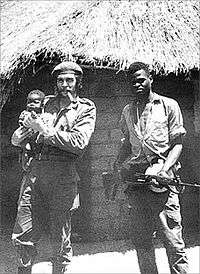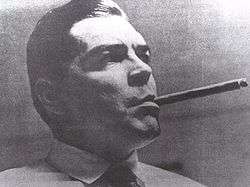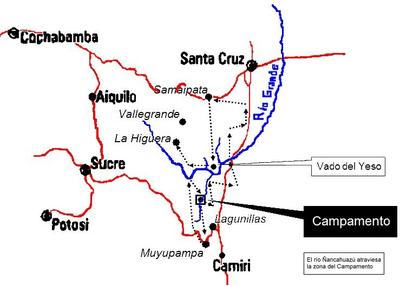Ñancahuazú Guerrilla
The Ñancahuazú Guerrilla or Ejército de Liberación Nacional de Bolivia (National Liberation Army of Bolivia; ELN) was a group of mainly Bolivian and Cuban guerrillas led by the guerrilla leader Che Guevara which was active in the Cordillera Province of Bolivia from 1966 to 1967. The group established its base camp on a farm across the Ñancahuazú river, a seasonal tributary of the Rio Grande, 250 kilometers southwest of the city of Santa Cruz de la Sierra. The guerrilla was intended to work as a foco, a point of armed resistance to be used as a first step to overthrow the Bolivian government and create a socialist state. The guerrillas defeated several Bolivian patrols before they were beaten and Guevara was captured and executed. Only five guerrillas managed to survive and flee to Chile.
| Bolivian Campaign | |||||||
|---|---|---|---|---|---|---|---|
| Part of the Cold War | |||||||
 Che Guevara in Bolivia in 1967. | |||||||
| |||||||
| Belligerents | |||||||
|
Ejército de Liberación Nacional | |||||||
| Commanders and leaders | |||||||
|
|
| ||||||
| Strength | |||||||
|
29 Bolivians 25 Cubans 3 Peruvians 1 Argentine-Cuban (Che) 1 Argentine-German (Tania) |
600 Bolivian Rangers 24 Americans | ||||||
| Casualties and losses | |||||||
| 55 killed or captured | Unknown | ||||||
Background
Congo Crisis

Che Guevara was committed to ending American imperialism, and he decided to travel to the Congo during its civil war to back the anti-capitalist guerrilla groups. Guevara's aim was to export the revolution by instructing local anti-Mobutu Simba fighters in Marxist ideology and foco theory strategies of guerrilla warfare. In his Congo Diary, he cites the incompetence, intransigence and infighting of the local Congolese forces as key reasons for the insurgency's failure.[3] On November 20, 1965, in ill health with dysentery, suffering from acute asthma, and disheartened after seven months of frustrations and inactivity, Guevara left the Congo with the Cuban survivors (six members of his 12-man column had died). At one point, Guevara considered sending the wounded back to Cuba, and fighting in Congo alone until his death, as an ideological example. After being urged by his comrades and pressed by two emissaries sent by Castro, at the last moment, Guevara reluctantly agreed to leave Africa. In speaking about his experience in the Congo months later, Guevara concluded that he left rather than fight to the death because: "The human element for the revolution in the Congo had failed. The people have no will to fight. The revolutionary leaders are corrupt. In simple words... there was nothing to do."[4] A few weeks later, when writing the preface to the diary he kept during the Congo venture, he began: "This is the story of a failure."[5]
At a meeting in Madrid, Juan Perón, who was sympathetic to Guevara but disapproved of Guevara's choice of guerrilla warfare as antiquated, warned Guevara about starting operations in Bolivia.[6]
...you will not survive in Bolivia. Suspend that plan. Search for alternatives. [...] Do not commit suicide.
— Juan Perón to Che Guevara[6]
Guerrilla operations


Che Guevara entered Bolivia with the pseudonym "Adolfo Mena González" on November 3, 1966. Three days later, he left the capital city of La Paz for the countryside. He planned to organize a foco with Bolivia as his target. Planning to start a guerrilla campaign against the military government of President René Barrientos, he assembled a band of 29 Bolivians, 25 Cubans, and a few foreigners which included Guevara himself, one woman from East Germany named Tamara Bunke, and three Peruvians. This small but well-armed group carried out two successful ambushes against two army patrols in the spring of 1967, but failed to gain significant support from fellow opposition groups in Bolivia's cities or from local civilians, some of whom willingly informed the authorities of the guerrilla's movements. By mid 1967, Guevara's men soon became fugitives, hunted down by Bolivian special forces and their American advisers. In the last few months of the venture, Guevara wrote in his diary that: "Talking to these peasants is like talking to statues. They do not give us any help. Worse still, many of them are turning into informants." On August 31, 1967, a small group of Guevara's soldiers, totaling eight men as well as Tamara Bunke, were ambushed and killed by Bolivian soldiers while they were attempting to cross the Rio Grande in Bolivia. On October 8, 1967, most of Guevara's surviving soldiers were surrounded and destroyed as a fighting force. Still, some were still active across Bolivia during the rest of October and November 1967. Barrientos was very concerned with Guevara's rising insurgency there, and clamped down in the area with some very heavy-handed measures (such as the Massacre of San Juan). Guevara felt that such an atrocity by the Bolivian Army and Air Force would be the tipping point in his favour in rallying the miners to his Communist cause, but eventually the miners signed with government-owned mining company, COMIBOL, an agreement which Guevara felt undermined his reason for being there.
Crackdown
Félix Rodríguez, a Cuban exile turned CIA Special Activities Division operative, advised Bolivian troops during the hunt for Guevara in Bolivia.[7] In addition, the 2007 documentary My Enemy's Enemy, directed by Kevin Macdonald, alleges that Nazi war criminal Klaus Barbie aka "The Butcher of Lyon", advised and possibly helped the CIA orchestrate Guevara's eventual capture.[1]
On October 7, a local informant apprised the Bolivian Special Forces of the location of Guevara's guerrilla encampment in the Yuro ravine.[8] On October 8, they encircled the area with 1,800 soldiers, and Guevara was wounded and taken prisoner while leading a detachment with Simeon Cuba Sarabia. Che biographer Jon Lee Anderson reports Bolivian Sergeant Bernardino Huanca's account: that a twice wounded Guevara, his gun rendered useless, shouted "Do not shoot! I am Che Guevara and worth more to you alive than dead."[9] Guevara was tied up and taken to a dilapidated mud schoolhouse in the nearby village of La Higuera on the night of October 8. For the next half day, Guevara refused to be interrogated by Bolivian officers and would only speak quietly to Bolivian soldiers. One of those Bolivian soldiers, helicopter pilot Jaime Nino de Guzman, describes Che as looking "dreadful". According to de Guzman, Guevara was shot through the right calf, his hair was matted with dirt, his clothes were shredded, and his feet were covered in rough leather sheaths. Despite his haggard appearance, he recounts that "Che held his head high, looked everyone straight in the eyes and asked only for something to smoke." De Guzman states that he "took pity" and gave him a small bag of tobacco for his pipe, with Guevara then smiling and thanking him.[10] Later on the night of October 8, Guevara, despite having his hands tied, kicked Bolivian Officer Captain Espinosa into the wall, after the officer entered the schoolhouse in order to snatch Guevara's pipe from his mouth as a souvenir.[11] In another instance of defiance, Guevara spat in the face of Bolivian Rear Admiral Ugarteche shortly before his execution.[11]
The following morning on October 9, Guevara asked to see the "maestra" (school teacher) of the village, 22-year-old Julia Cortez. Cortez would later state that she found Guevara to be an "agreeable looking man with a soft and ironic glance" and that during their short conversation she found herself "unable to look him in the eye", because his "gaze was unbearable, piercing, and so tranquil."[11] During their short conversation, Guevara pointed out to Cortez the poor condition of the schoolhouse, stating that it was "anti-pedagogical" to expect campesino students to be educated there, while "government officials drive Mercedes cars" ... declaring "that's what we are fighting against."[11]
Later that morning on October 9, Bolivian President René Barrientos ordered that Guevara be killed. The order was relayed by Félix Rodríguez to the Bolivian army unit holding Guevara, reportedly despite the US government's desire that Guevara be taken to Panama for further interrogation.[12] The executioner was Mario Terán, a sergeant in the Bolivian army who had requested to shoot Che on the basis of the fact that three of his friends from B Company, all named "Mario", had been killed in an earlier firefight with Guevara's band of guerrillas.[13] To make the bullet wounds appear consistent with the story the government planned to release to the public, Félix Rodríguez ordered Terán not to shoot Guevara in the head, but to aim carefully to make it appear that Guevara had been killed in action during a clash with the Bolivian army.[14] Gary Prado, the Bolivian captain in command of the army company that captured Guevara, said that the possible reasons Barrientos ordered the immediate execution of Guevara is so there would be no possibility that Guevara would escape from prison, and also so there would be no drama in regard to a trial.[15]
Before Guevara was executed he was asked by a Bolivian soldier if he was thinking about his own immortality. "No", he replied, "I'm thinking about the immortality of the revolution."[16] A few minutes later, Sergeant Terán entered the hut and ordered the other soldiers out. Alone with Terán, Che Guevara then stood up and spoke to his executioner: "I know you've come to kill me." Terán pointed his M2 carbine at Guevara, but hesitated in which Guevara spat at Terán which were his last words: "Shoot, coward! You are only going to kill a man!"[17] Terán then opened fire, hitting Guevara in the arms and legs. For a few seconds, Guevara writhed on the ground, apparently biting one of his wrists to avoid crying out. Terán then fired several times again, wounding him fatally in the chest at 1:10 pm, according to Rodríguez.[17] In all, Guevara was shot by Terán nine times. This included five times in the legs, once in the right shoulder and arm, once in the chest, and finally in the throat.[11]
Months earlier, during his last public declaration to the Tricontinental Conference,[18] Guevara wrote his own epitaph, stating "Wherever death may surprise us, let it be welcome, provided that this our battle cry may have reached some receptive ear and another hand may be extended to wield our weapons."[19]
Aftermath
After he was killed, Guevara's body was lashed to the landing skids of a helicopter and flown to nearby Vallegrande, where photographs were taken of him lying on a concrete slab in the laundry room of the Nuestra Señora de Malta.[20] As hundreds of local residents filed past the body, many of them considered Guevara's corpse to represent a "Christ-like" visage, with some of them even surreptitiously clipping locks of his hair as divine relics.[21] Such comparisons were further extended when two weeks later upon seeing the post-mortem photographs, English art critic John Berger observed that they resembled two famous paintings: Rembrandt's The Anatomy Lesson of Dr. Nicolaes Tulp and Andrea Mantegna's Lamentation over the Dead Christ.[22] There were also four correspondents present when Guevara's body arrived in Vallegrande, including Bjorn Kumm of the Swedish Aftonbladet, who described the scene in a November 11, 1967, exclusive for The New Republic.[23]
Bolivia had defeated its last major insurgency to date. President Barrientos himself died on April 27, 1969, in a helicopter crash. Most of Guevara's men were killed, wounded, or captured in the campaign.
On February 17, 1968 five surviving guerrillas, three Cubans and two Bolivians, managed to get to Chile. There they were detained by policing carabiniers and sent to Iquique. On February 22, the guerrillas applied for asylum. While in Iquique they were visited by Salvador Allende, then president of the senate of Chile. After the guerrilla's meeting with Allende and other prominent leftist politicians the interior minister of the Christian Democrat government Edmundo Pérez Zujovic decided to expel the guerrillas from Chile. Due to problems in obtaining transit visas the journey to Cuba was done via Tahiti and New Zealand.[24]
After the failure of Guevara's guerrilla, radical leftists in Bolivia began to organize again to set up guerrilla resistance in 1970 in what is known today as the Teoponte Guerrilla.
Fernando Gómez, a former member of the Ñancahuazú Guerrilla, led the formation of Salvador Allende's informal bodyguard prior to the 1970 Chilean presidential election.[25] By the time of the election, the bodyguard had expanded with the addition of more ex-Ñancahuazú Guerrillas volunteering to provide security to Allende and, later, members of the Revolutionary Left Movement (MIR).[25] On one of Allende's first public appearances after his inauguration, a Chilean journalist inquired of the president who the armed men were accompanying him, to which Allende replied "a group of personal friends", giving the group the moniker from which it would thereafter be known.[26]
References
- Barbie "Boasted of Hunting Down Che" by David Smith, The Observer, December 23, 2007.
- Richard Gott, "Major Ralph Shelton obituary", The Guardian, 6 September 2010. Note: Major Shelton commanded the US unit.
- Ireland's Own 2000.
- Kellner 1989, p. 87.
- Guevara 2000, p. 1.
- O'Donnell, Pacho (October 8, 2012). "Opiniones de Perón sobre el Che". Pagina 12 (in Spanish). Retrieved September 28, 2015.
- Shadow Warrior: The CIA Hero of 100 Unknown Battles, Felix Rodriguez and John Weisman, Simon & Schuster, October 1989.
- Green Beret Behind the Capture of Che Guevara by Richard Gott, The Age, September 8, 2010
- Anderson 1997, p. 733.
- "The Man Who Buried Che" by Juan O. Tamayo, Miami Herald, September 19, 1997.
- Ray, Michèle (March 1968). "In Cold Blood: The Execution of Che by the CIA". Ramparts Magazine: 33.
- Grant 2007
- Taibo 1999, p. 267.
- Grant 2007. René Barrientos has never revealed his motives for ordering the summary execution of Guevara.
- Almudevar, Lola. "Bolivia marks capture, execution of 'Che' Guevara 40 years ago." San Francisco Chronicle. Tuesday October 9, 2007. Retrieved on November 7, 2009.
- Time magazine 1970.
- Anderson 1997, p. 739.
- Message to the Tricontinental A letter sent by Che Guevara from his jungle camp in Bolivia, to the Tricontinental Solidarity Organisation in Havana, Cuba, in the Spring of 1967.
- Obituary: Che Guevara, Marxist Architect of Revolution by Richard Bourne, The Guardian, October 11, 1967
- Almudevar 2007 and Gott 2005.
- Casey 2009, p. 179.
- Casey 2009, p. 183.
- The Death of Che Guevara by Bjorn Kumm, The New Republic, Originally published on November 11, 1967.
- Salvador Allende, internacionalista. Punto Final. May 16, 2008.
- Harmer, Tanya (2020). Beatriz Allende: A Revolutionary Life in Cold War Latin America. University of North Carolina Press. pp. 158–159. ISBN 146965430X.
- Pérez, Cristián (Winter 2000). "Salvador Allende: Notes on his Security Team". Estudios Públicos. Centro de Estudios Públicos (79): 20, 28–35.